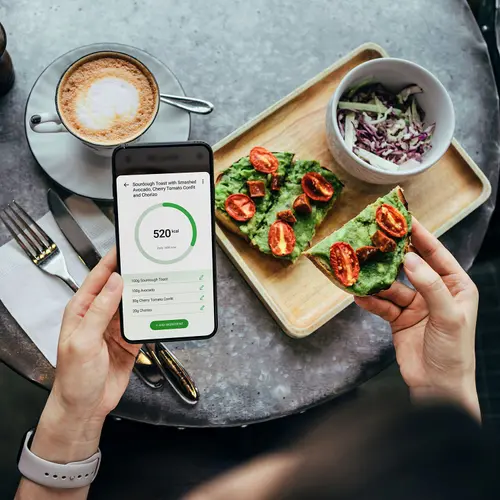Most health experts recommend that you eat a balanced, healthy diet to maintain or to lose weight. But exactly what is a healthy diet?
It should include:
- Protein (found in fish, meat, poultry, dairy products, eggs, nuts, and beans)
- Fat (found in animal and dairy products, nuts, and oils)
- Carbohydrates (found in fruits, vegetables, whole grains, and beans and other legumes)
- Vitamins (such as vitamins A, B, C, D, E, and K)
- Minerals (such as calcium, potassium, and iron)
- Water (both in what you drink, and what's naturally in foods)
Dieting or not, everyone needs a mix of those nutrients, ideally from foods. A good general rule is to use MyPlate, which makes it easy to envision just how much of each food type to include in your meal.
Fill half your plate with fruits and vegetables. Split the other half between whole grains and lean protein. Stick to your calorie “budget,” because when you're working on losing weight, you need to burn more calories than you eat or drink.
Exactly how many calories you should get per day depends on your goal, your age, your sex, and how active you are. A dietitian can help you figure that out. Don't cut your calories too much, or your diet is going to be hard to stick with and may not give you the nutrients your body needs.
More tips:
- Choose nonfat or 1% milk instead of 2% or whole milk.
- Pick lean meat instead of fatty meat.
- Select breads and cereals that are made with whole grains and are not prepared with a lot of fat.
- You don't have to completely avoid all foods that have fat, cholesterol, or sodium. It's your average over a few days, not in a single food or even a single meal, that's important.
- If you eat a high-calorie food or meal, balance your intake by choosing low-calorie foods the rest of the day or the next day.
- Check the food labels on packaged foods to help you budget fat, cholesterol, and sodium over several days.
That's just the start of what you might want to know about nutrition for weight loss. Keep learning as much as you can, including the following terms.
Calories
Calories are a measurement, like an inch or a tablespoon. They note how much energy is released when your body breaks down food. The more calories a food has, the more energy it can provide to the body.
When you eat more calories than you need, your body stores the extra calories as fat. Even low-carb and fat-free foods can have a lot of calories that can be stored as fat.
Protein
Proteins help repair and maintain your body, including muscle. You can get protein in all types of food. Good sources include fish, meat, poultry, eggs, cheese, nuts, beans, and other legumes.
Fats
Your body needs some fat. But most Americans get too much of it, which makes high cholesterol and heart disease more likely.
There are several types of fats:
- Saturated fats: found in cheese, meat, whole-fat dairy products, butter, and palm and coconut oils. You should limit these. Depending on whether you have high cholesterol, heart disease, diabetes, or other conditions, a dietitian or your doctor can let you know your limit.
- Polyunsaturated fats: These include omega-3 fatty acids (found in soybean oil, canola oil, walnuts, flaxseed, and fish including trout, herring, and salmon) and omega-6 fatty acids (soybean oil, corn oil, safflower oil).
- Monounsaturated fats: These come from plant sources. They're found in nuts, vegetable oil, canola oil, olive oil, sunflower oil, safflower oil, and avocado.
- Cholesterol: Another type of fat found in foods that come from animals.
- Trans fat: Some trans fat is naturally found in fatty meat and dairy products. Artificial trans fats have been widely used in packaged baked goods and microwave popcorn. They're bad for heart health, so avoid them as much as possible. Although trans fats are less common in recent years, you can still look at the nutrition facts label to see how much trans fat is in an item. Know that something that says "0 g trans fat" may actually have up to half a gram of trans fat in it. So also check the ingredients list: If it mentions "partially hydrogenated" oils, those are trans fats.
Carbohydrates
Carbohydrates give your body fuel in the form of glucose, which is a type of sugar. Adults should get about 35% to 55% of their calories from carbohydrates. Most Americans eat too many carbohydrates, especially processed carbs, leading to obesity, prediabetes, and diabetes.
Some carbs are rich in nutrients. Those include whole grains, fruits, vegetables, and legumes.
Other carbs are sugary and starchy, and not high in nutrients. You should limit those, which include candy, pastries, cookies, chips, soft drinks, and fruit drinks.
Vitamins
Vitamins help with chemical reactions in the body. In general, vitamins must come from the diet; the body doesn't make them.
There are 13 essential vitamins. Your body can store vitamins A, D, E, and K, and it can be a problem if you get too much of them. Vitamin C and the B vitamins don't build up in your body, so you need to keep getting them regularly in your diet.
Minerals
Minerals, like vitamins, must come from the diet. Your body needs them, but it can't make them.
You need more of some minerals (such as calcium, potassium, and iron) than others. For instance, you need only small amounts of the minerals zinc, selenium, and copper.
What About Water?
Water has no calories or nutrients, but it keeps you hydrated. It also makes up 55%-65% of body weight. You can drink water or get it from foods that naturally have water in them, like fruits and vegetables.

